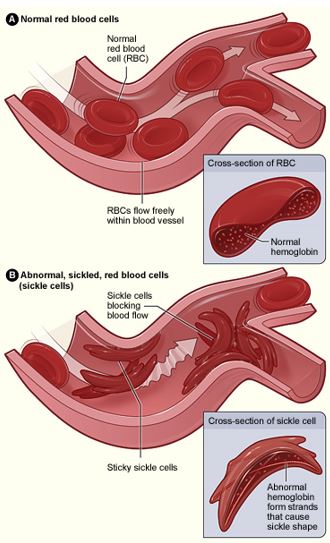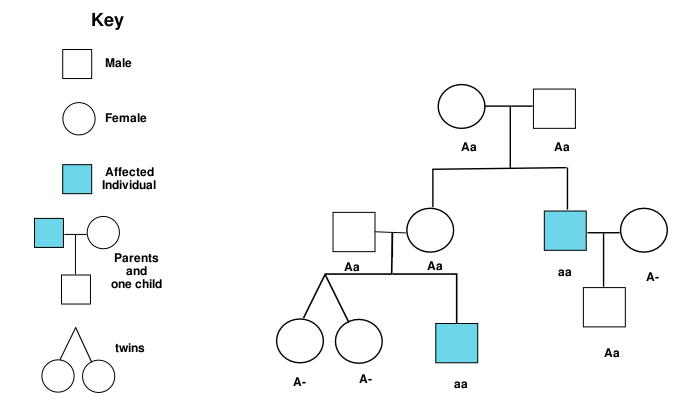Sickle cell anaemia is a hereditary disease passed down from parents to their children. The red blood cells, which are typically disc-shaped, take an abnormal shape and form a crescent or sickle form. The disease shortens the lifespan of the people infected by weakening the body’s immunity system thereby making one vulnerable to diseases. Sickle cell anaemia has a high prevalence among people of African descent as well as those in the Mediterranean. In America, African Americans have a high prevalence rate (National Heart Lung and Blood Institute, 2010). The disease has increased in Europe in recent years (Roberts and Montalembert, 2007).
The symptoms of the disease start showing after a baby reaches four months. Nearly, all the patients suffering from sickle cell experience painful crises, which vary in length. Sickle cell anaemia leads to two kinds of pains -acute and chronic. Acute pain is very common and lasts for hours or days. The chronic pain is severe and can last for months. It is difficult to bear and limits one’s functionality. The symptoms related to pain or crises are a pain in the bones, chest and joints. The crises occur because the sickle-shaped red blood cells clog becoming sticky and prevents blood from flowing smoothly in the blood vessels. The restriction of blood flow causes pain and eventually leads to the damage of organs, for instance, the spleen. Other symptoms are associated with anaemia. It means that some people exhibit mild symptoms while others exhibit severe symptoms. The commonest symptom of sickle cell anaemia is fatigue where patients generally feel very weak and tired. Other signs and symptoms are dizziness, running out of breath, paleness, headaches, fever and cold feet and hands. Sickle cell anaemia leads to health problems such as eye problems, gallstones, priapism in males or unwanted erections, ulcers that appear on the legs, stunted growth in children and strokes (Vorvick, 2010).
The red blood cells are responsible for carrying oxygen. They contain hemoglobin- a protein that helps to carry oxygen. The red color of the blood comes from hemoglobin. However, in a person with sickle cell anaemia there is an abnormality caused by an abnormal type of protein known as hemoglobin S. The hemoglobin distorts the figure of the red blood cells giving them a sickle cell form due to low exposure to oxygen (Vorvick, 2010). The sickle-shaped cells are fragile and carry less oxygen. The abnormal Sickle cells clog very easily forming clumps and disintegrating into pieces thus interfering with the normal blood flow. Normally, the red blood cells, which have the shape of a disc, move easily through the blood cells transporting oxygen to the rest of the body through the blood vessels but the sickle cells become sticky and stiff hence cannot move easily through the blood vessels as shown in Image 1 (Lab Tests Online, 2010).

The mode of sickle cell inheritance is X-linked and is carried on chromosomes. Thus, a person can be a carrier of a genetic diseases trait without even being aware and passing it to their children. Sickle cell anaemia is passed down to generations when they inherit two defective genes from each parent or become carriers of the trait if they inherit only one defective gene from one of the parents see Image 2.

Haemoglobin F is produced during the gestation period by a fetus. After birth hemoglobin F is replaced by hemoglobin A. The variations in hemoglobin result from gene mutations. Other hemoglobin variants are available but few are common. The changes in the hemoglobin give rise to variants such as hemoglobin C, hemoglobin S and beta-thalassemia (Lab Tests Online, 2010).
People with hemoglobins and a normal hemoglobin gene copy produce 20-40% of hemoglobins and do not generally exhibit any health problems because they manufacture adequate hemoglobin A. Such people have a single altered copy of hemoglobin (heterozygous) and they only carry a trait of sickle cell anaemia. The carriers of sickle cell anaemia have a recessive gene that when passed to the offspring causes the disease. On the contrary, the homozygous- people who carry two mutated hemoglobin genes have hemoglobin S and are thus victims of sickle cell anaemia. The homozygous does not produce the normal hemoglobin A (Lab Tests Online, 2010).
The mutated hemoglobin S produces a less soluble type of hemoglobin and fluid that forms polymers during the process of oxygen transport within the red blood cells. The polymers are responsible for altering the shape of the red blood cells giving them a crescent or sickle shape. The shape altering occurs in low oxygen environments, which causes problems for the blood circulatory system (Lab Tests Online, 2010).
The disease has no cure but can be managed through various treatments, which should be given even during crises free periods. The patients need to take folic acid supplements that help in the production of red blood cells as the sickle cells are short-lived and last between 10-20 days instead of the normal span of 120 days (Vorvick, 2010). The treatments help to reduce the occurrences of crises and control the symptoms. Pain medicines are administered during pain crises. Drinking fluids also help to reduce dehydration, which leads to crises. In periods of crisis, non-narcotic drugs may be used but some patients require the use of narcotic drugs in large doses. Another drug like hydroxyurea is used to alleviate pain and difficulties in breathing. In children, vaccines and antibiotic drugs are used to avoid bacterial infections. In severe cases, blood transfusions are done regularly to prevent occurrences of strokes. When kidney damage occurs dialysis can be done or a kidney transport. Surgery can be performed on patients with priapism. Gall bladder removal in case a patient has gallstone disease. Eye operations for those with eye problems and wound care for the ulcers on the legs. Moreover, bone marrow transplants can be done but involve many risks such as infections or rejection (Vorvick, 2010). Patients need to see a doctor frequently.
References
Lab Tests Online. 2010. Sickle cell Anaemia. Web.
National Heart Lung and Blood Institute. 2010. Sickle cell Anaemia. Web.
Roberts, I. and Montalembert, M., 2007. Sickle cell disease as a paradigm of immigration haematology: new challenges for haematologists in Europe. Haematological, 92 (7), pp. 865–71.
Vorvick, L., 2010. Sickle cell anaemia. Web.